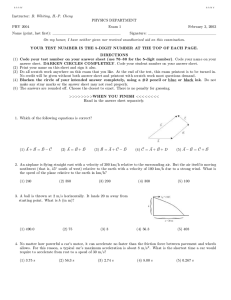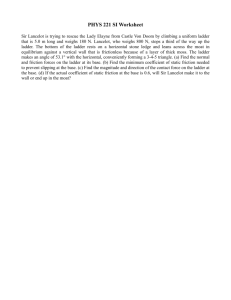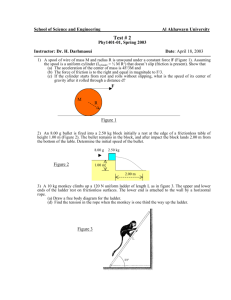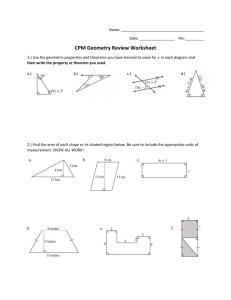July 18, 2008 PHY2053 Discussion Quiz 7 (Chapter 7.1-8.4)
advertisement
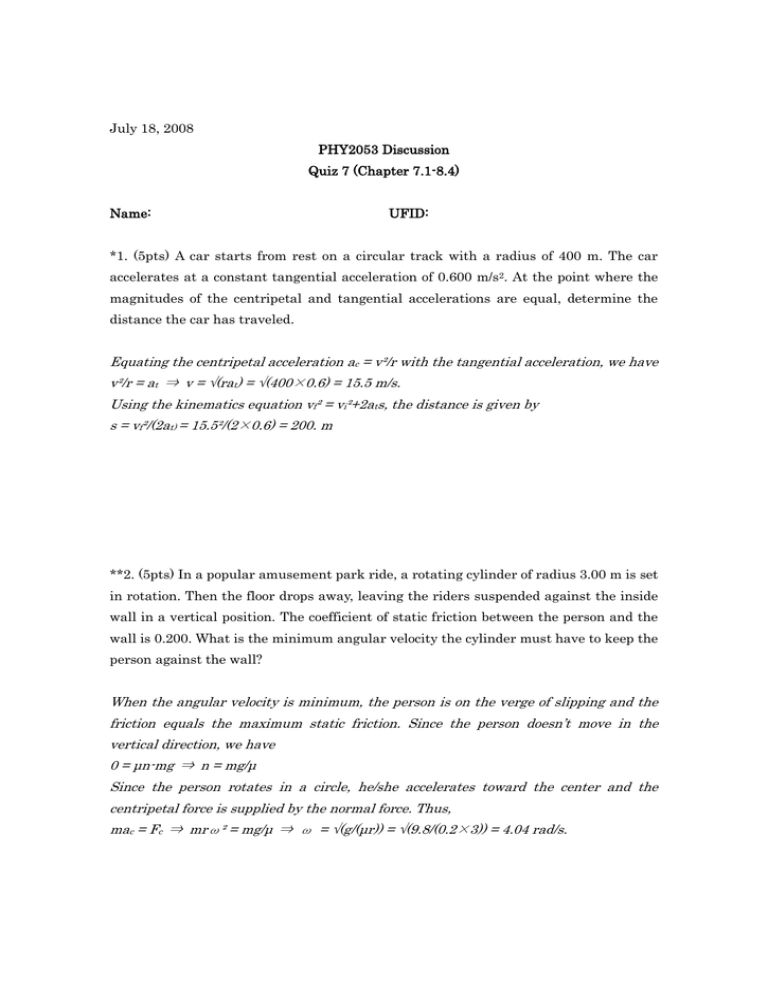
July 18, 2008 PHY2053 Discussion Quiz 7 (Chapter 7.1-8.4) Name: UFID: *1. (5pts) A car starts from rest on a circular track with a radius of 400 m. The car accelerates at a constant tangential acceleration of 0.600 m/s2. At the point where the magnitudes of the centripetal and tangential accelerations are equal, determine the distance the car has traveled. Equating the centripetal acceleration ac = v²/r with the tangential acceleration, we have v²/r = at ⇒ v = √(rat) = √(400×0.6) = 15.5 m/s. Using the kinematics equation vf² = vi²+2ats, the distance is given by s = vf²/(2at) = 15.5²/(2×0.6) = 200. m **2. (5pts) In a popular amusement park ride, a rotating cylinder of radius 3.00 m is set in rotation. Then the floor drops away, leaving the riders suspended against the inside wall in a vertical position. The coefficient of static friction between the person and the wall is 0.200. What is the minimum angular velocity the cylinder must have to keep the person against the wall? When the angular velocity is minimum, the person is on the verge of slipping and the friction equals the maximum static friction. Since the person doesn’t move in the vertical direction, we have 0 = μn-mg ⇒ n = mg/μ Since the person rotates in a circle, he/she accelerates toward the center and the centripetal force is supplied by the normal force. Thus, mac = Fc ⇒ mrω² = mg/μ ⇒ ω = √(g/(μr)) = √(9.8/(0.2×3)) = 4.04 rad/s. *3. (5pts) Two objects attract each other with a gravitational force of magnitude 4.00× 10-8 N when separated by 50.0 cm. If the total mass of the objects is 30.0 kg, what is the mass of each? Expressing the mass of the one of the objects in terms of the other, we substitute the expression in the formula for universal gravitation. Then we solve it for the mass. m1+m2 = 30 ⇒ m2 = 30-m1 F = Gm1m2/r² ⇒ F = Gm1(30-m1)/r² ⇒ m1²-30m1+Fr²/G = 0 ⇒ m1²-30m1+ 4×10-8×0.5²/(6.673×10-11) = 0 ⇒ m1²-30m1+150 = 0 m1 = (30±√(30²-4×150))/2 = 23.66 kg and 6.34 kg ***4. (5pts) A 5.00 m, 30.0 kg uniform ladder rests against a vertical wall, making an angle of 60.0˚ to the ground. The coefficient of static friction between the ladder and the wall is 0.200, and that between the ladder and the ground is 0.300. How far along the ladder can a 60.0-kg person move up before the ladder begins to slip? When the ladder is on the verge of slipping, the frictions at the top and at the bottom are both maximum (f1 = μ1n1 and f2 =μ2n2). Applying the translational equilibrium condition ΣF = 0, we solve the equations for n1. ΣFy = 0 ⇒ f1+n2-mg-Mg = 0 ⇒ n2 = (m+M)g-μ1n1 ΣFx = 0 ⇒ n1- f2 = 0 ⇒ n1-μ2((m+M)g-μ1n1) = 0 ⇒ n1 = μ2(m+M)g/(1+μ1μ2) = 0.3×(60+30)×9.8/(1+0.2×0.3) = 250. N Applying the rotational equilibrium conditions around the base of the ladder, we have -Mg(L/2)cosθ-mglcosθ+n1Lsinθ+μ1n1Lcosθ l = [n1L(sinθ+μ1cosθ)-Mg(L/2)cosθ]/(mgcosθ) = [250×5(sin60˚+0.2cos60˚)-30×9.8×2.5cos60˚]/(60×9.8cos60˚) = 2.86 m.
